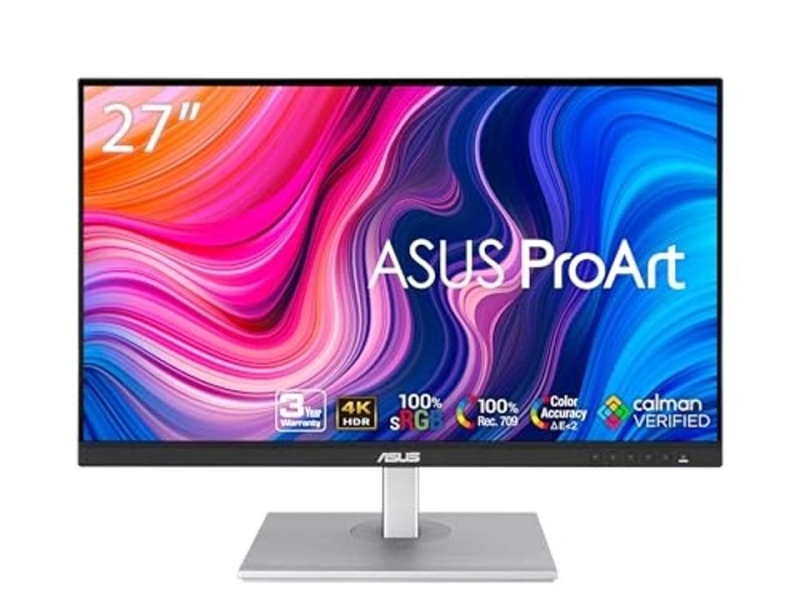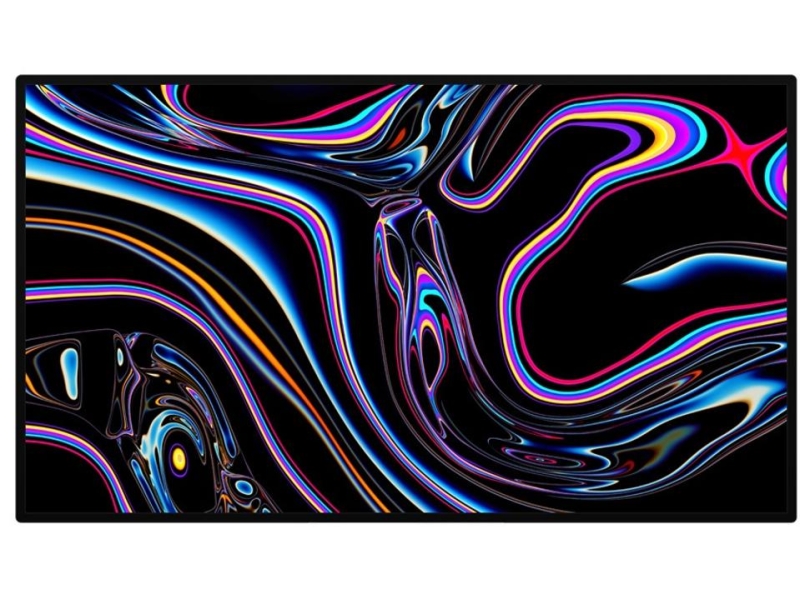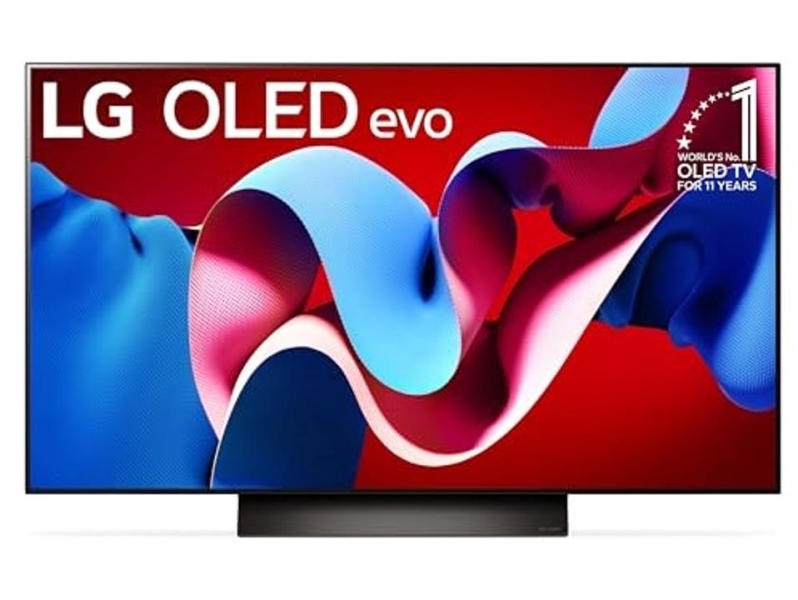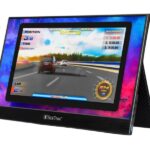
BenQ SW321C 32-Inch
Size: 32-inch | Type: IPS |Resolution: 3840 x 2160 | Refresh rate: 60 Hz | Response time: 5 ms | Color accuracy: E < 2
Best for: High-end video editing at 4K resolution or beyond.
Pros:
- Excellent color accuracy and wide color gamut support
- Great picture quality
- Fast response time for a professional monitor
Cons:
- Limited HDR support
- Doesn’t support the latest connection technologies
If you’re a professional video editor or want to take your video editing to new heights of color accuracy, the BenQ SW321C is the ideal tool for the job. With a high 4K resolution, it has an impressive response time for a professional monitor to avoid ghosting on fast motion in video, and its IPS panel gives it a wide viewing angle. But it’s the color support that really drives this display into the top spot of the best monitors for video editing. It’s rated with a delta E less than 2 for professional-level color accuracy, and has native support for 10 bit color—and a 16-bit lookup table that can help improve color blending.
It supports 100% of the sRGB and Rec. 709 color gamuts, 99% of the Adobe RGB gamut, and 95% of the PCI-D3 gamut. It doesn’t have the highest brightness, but it’s compatible with both HDR10 and HLF formats, so it’s still useful for video editing HDR. It has two HDMI 2.0 ports, a DisplayPort 1.4 port and a USB-C port with support for 60W power delivery and up to 5Gbps data transfer. It also has a pair of USB-A ports, a legacy USB-B port and a 3.5 mm audio jack.
Best Budget Monitor For Video Editing
Edit Your Videos For Less Than $1,000

Dell UltraSharp U2723QE 27-Inch
Size: 27-inch | Type: IPS |Resolution: 3840 x 2160 | Refresh rate: 60 Hz | Response time: 5 ms | Color accuracy: Unknown
Best for: High-end video editing on a budget.
Pros:
- Excellent color gamut support
- Affordably priced
- Strong connectivity
Cons:
- Lacks super high-brightness of Mini-LED monitors
- 27 inches might be a bit small for some editors
Need a bright, colorful, vibrant monitor for video editing but don’t have bottomless pockets? The Dell UltraSharp U2723QE is a great solution. It can compete with many of the top monitors on a range of important specifications and features, and yet comes in with a price tag barely north of $500. Find it on sale, and you might find it closer to $400. But whether you’re paying the full price or a heavy discounted one, you get the same excellent IPS panel with wide viewing angles, a high 4K resolution for detailed video editing, a high brightness and strong HDR support.
It’s certified at VESA DisplayHDR 400, so you can rest assured it gets plenty bright, and supports the most important HDR standards for eye popping visuals, whatever you’re editing. It supports 100% Rec 709, 100% sRGB and 98% of the DCI-P3 color gamut. Its connectivity is particularly strong too, with support for USB-C with up to 90W USB power delivery, Gigabit Ethernet, DisplayPort 1.4 and HDMI 2.0. There’s even a quick access USB-C for charging your smartphone and fast USB-A ports for 10 Gbps data transfer.
Honorable Mention: A Gorgeous 4K Screen For Under $400

Asus ProArt Display PA279CV 27-Inch
Size: 27-inch | Type: IPS |Resolution: 3840 x 2160 | Refresh rate: 60 Hz | Response time: 5ms | Color accuracy: Delta E < 2
Best for: Video editing at up to 4K resolution on a tight budget.
Pros:
- Affordably priced
- Strong color accuracy
- Comes with a Calman certified factory calibration
Cons:
- 27-inches might be too small for some video editors
If you want to edit high quality video with accurate colors but don’t want to spend more than $500, Asus has you covered. The Asus ProArt Display PA279CV is an excellent display for video editing, thanks to its 4K resolution and impressive color accuracy. With a Delta E < 2, it’s more accurate than many more expensive monitors and even some designed with creatives in mind. This is an IPS monitor with a strong contrast and reasonable brightness of 350 nits. That’s not enough to really grade the brightest of HDR highlights, but you can still get an idea of what it might look like in the finished product on brighter displays.
It comes with a range of handy presets depending on the video style you’re targeting, letting you quickly reconfigure the monitor for your needs. It offers strong support for the sRGB colour spectrum, with 100% of the gamut covered. Though it doesn’t offer the same extensive coverage of other gamuts, it is Calman certified for a strong factory calibration, so should look fantastic and accurate right out of the box.
Best 8K Monitor For Video Editing
Still The Best

Dell Ultrasharp UP3218K
Size: 32-inch | Type: IPS |Resolution: 7680 x 4320 | Refresh rate: 60 Hz | Response time: 6 ms | Color accuracy: E > 2
Best for: Editing ultra high definition video.
Pros:
- Gorgeous picture with incredible color support
- Supports native 8K resolution
- Excellent warranty and support coverage
Cons:
- Older ports
- Expensive
Finding a good 8K monitor is tricky, even in 2024, so it might be a surprise that the best 8K monitor for video editing is one that’s been around for a few years now. But the Dell Ultrasharp UP3218K is still king when it comes to 8K monitors for video editing. It has an eye watering resolution of 7680 x 4320, which you’ll struggle to find on even the best monitors. It also has a high brightness at up to 400 nits, which is plenty for video editing in SDR or HDR modes, and at 32-inches you get lots of screen space to dig into the details of the video you’re working on.
It’s the color accuracy and support which truly sets this monitor apart, though. It has 100% of the AdobeRGB, sRGB, and Rec. 709 colot gamuts and 98% support of DCI-P3 for immaculate colors. With a color accuracy less than 2, and it comes with a factory calibration report to prove it. You can tweak it further yourself if you want, but you’ll need a hardware colorimeter to get results as good as this. It has a robust stand that allows rotation into portrait mode, which can be great if you want a tall editing timeline. It’s also part of Dell’s Premium Panel Guarantee; you get free panel replacement in the three years it’s covered by its hardware warranty, and it comes with Dell Pro Support for a higher-level support response if you need it.
Best Monitor For Video Editing On A Mac
Apple’s King Still Wears The Crown

Apple Pro Display XDR 32-Inch
Size: 32-inch | Type: IPS |Resolution: 6016 x 3384 | Refresh rate: 60 Hz | Response time: Unknown | Color accuracy: Unknown
Best for: Editing ultra high definition video on a Mac.
Pros:
- Incredible picture quality
- Very bright
- Amazing contrast and color support
Cons:
- Expensive
- Limited connectivity options
- Stand costs extra
Apple’s Pro Display XDR is a little older than some of its contemporaries, but they still can’t hold a candle to its impressive array of specifications and features, especially if you’re video editing on a Mac. It has incredible color support, with supreme accurate, support for 10-bit color, and it gets crazy bright—up to 1,600 nits in HDR mode, and over 1,000 nits sustained brightness for eye-popping HDR content. If you’re editing HDR video, you need to have a monitor that can display it correctly, and the Pro Display XDR can do it and then some. Even its resolution is simply head and shoulders above the rest. At 6016 x 3384, it’s edging towards 8K territory.
For a non-OLED display, its contrast ratio is also very impressive, with a 1,000,000:1 rating to get super inky blacks and very bright whites. It comes pre-calibrated to a high level of color support, but there are a range of different modes you can use if you’re video editing for a certain platform or medium, including PAL video, Digital Cinema and NTSC. It doesn’t come with a stand as standard, but there is a highly capable option for a further $1,000. Alternatively, you can fit it with a VESA mount and mount it on an arm of your choice. It comes with USB-C and Thunderbolt ports, but little else in terms of connectivity. There’s also a nano-texture glass at an additional expense which can help with glare, but it’s not strictly necessary.
Best Premium Monitor For Video Editing
Worth The High Price

Eizo ColorEdge CG319X 32-Inch
Size: 32-inch | Type: IPS |Resolution: 4096 x 2160 | Refresh rate: 60 Hz | Response time: 9ms | Color accuracy: Unknown
Best for: Video editing with the most accurate colors possible.
Pros:
- Includes a range of professional color uniformity features
- Color accuracy is about as good as it gets
- 4K+ resolution looks crisp
Cons:
- Expensive
- Overkill for most hobbyist video editors
If you’re editing video for television broadcast, or want to simply give your viewers the most accurate colors possible in your video, then the Eizo ColorEdge CG319X is worth the (admittedly high) price of admission. It has a 4K+ resolution, giving you extra clarity in whatever you’re editing, but its the high color accuracy that makes it a true professional’s tool. It also has a high contrast ratio, incredible support across the most important color gamuts and strong HDR support. Eizo doesn’t list the color accuracy, but some reviewers tested it a a Delta E of just 0.3. For reference, anything under 2 is considered professional quality.
A unique feature of this monitor is its built-in temperature sensor, which adjusts the brightness, colors and other factors depending on the temperature of the monitor, which can have subtle effects on the way an LCD display works. This sensor ensures you don’t sacrifice that color accuracy just because you’re working on a warm day. This sensor even employs AI for better temperature management.
With the Eizo ColorEdge you can get to work right away, too. Where most monitors take 30 minutes or so to warm up to their natural colors and brightness levels, this monitor is ready to go in just three. It also utilizes a digital uniformity equalizer to make sure the LCD displays everything equally across the whole screen, and it has a luminance warning system that will tell you if your footage is too bright for various display devices and brightness levels.
Best Big Monitor For Video Editing
An Accurate TV Is Just As Good As An Accurate Monitor

LG C4 Evo OLED 48-Inch TV
Size: 48-inch | Type: IPS |Resolution: 3840 x 2160 | Refresh rate: 144 Hz | Response time: 0.1 ms | Color accuracy: Unknown
Best for: Video editing on a huge screen.
Pros:
- Gigantic screen with options for larger versions
- Strong color accuracy
- OLED contrast and color vibrancy are unmatched
Cons:
- Lacks some of the professional calibration features of pro monitors
The LG C4 has three big things going for it. First, it’s huge—good luck finding a professional grade video editing monitor at this size and aspect ratio. Secondly, it’s incredibly accurate, despite being a consumer-first TV. While LG doesn’t publish its Delta E number directly, it made big claims of improving color accuracy with this generation of OLED TV, and yet reviewers regularly found the LG C3 could deliver color accuracy as impressive as a Delta E of just 1.4. And thirdly, this is a consumer device, so if you want to edit video on a device that people may well watch your videos on, then this is a great solution.
Because it’s an OLED display, the LG C4 also delivers amazing contrast with the darkest of blacks and sky high brightness that makes HDR look incredible on this TV. It offers full support for HDR10, HLG and Dolby Vision, a native refresh rate of 120Hz (and the ability to go up to 144Hz), and it has an onboard AI processor for upscaling and image enhancement, if you want to use it.
Here at Forbes Vetted, we’re computer experts, having tested the latest devices to make your video editing workflow a smooth, easy experience.
- Executive editor Dave Johnson and tech editor Rebecca Isaacs are experts in consumer tech and are constantly testing and reviewing the latest products to hit the market. Johnson has also authored a number of books on the subject.
- Contributor Jon Martindale’s background is rooted in tech journalism, including performing a stint as the owner of a PC hardware review site. Now, he shares his passion for cutting-edge tech by regularly covering and reviewing hardware and accessories, including guides on the best Chromebooks and best gaming keyboards.
- We’ve published an extensive library of computer guides, including everything from wireless keyboards and mice to business laptops and MacBooks.
- To keep our advice up to date, we routinely update this guide. It was last refreshed in May 2024 to expand add frequently asked questions to help make an informed buying decision.
How We Chose The Best Monitors For Video Editing
We leveraged our editors tech expertise and hands-on experience reviewing PCs and displays while researching the best monitors for video editing and comparing the specs of each. Some of our picks come personally recommended by our editors.
- We reviewed each monitor’s specifications and features, and performed a deep comparison of all available competitor models, factoring in their brightness, panel type, refresh rate, resolution, response time, color accuracy and color gamut support, as well as pricing.
- All the monitors on this list needed outstanding customer reviews, with an average rating of no less than four out of five stars.
- Everyone has different work monitor needs, so we made sure to include a recommendation for creative hobbyists editors, professionals and those on a tight budget.
Is A 4K Monitor Worth It For Video Editing?
Absolutely, a 4K monitor is highly beneficial for video editing. It allows for a much higher level of detail and accuracy, crucial for editing high-resolution content. With 4K, you can see finer details in your footage and have more screen real estate for toolbars and timelines, which can streamline your workflow.
Is A Curved Or Flat Monitor Better For Video Editing?
Both curved and flat monitors have their advantages for video editing. Flat monitors are generally preferred for their accuracy in displaying straight lines and true perspectives, which is essential to get that precise video editing. However, curved monitors can offer a more immersive experience and reduce eye strain over long editing sessions. Our top pick, the BenQ SW321C, is a flat monitor instead of a curved, and was chosen for its color accuracy and extra features that make it ultimately the better choice. But it depends on your needs and preferences.
Is A 24-Inch Monitor Enough For Video Editing?
While a 24-inch monitor can suffice for video editing, larger screens are typically more comfortable and efficient, as you can see more detailing in your footage. A larger monitor, such as 27 inches or above, provides more workspace for your editing timeline, preview window and tools. This extra space can improve your workflow so you don’t need to constantly zoom in and out.
Is IPS Or OLED Better For Video Editing?
IPS panels are generally better for video editing due to their color accuracy, wide viewing angles and consistent performance. OLED monitors offer superior contrast with inky blacks and vibrant colors, but can be prone to burn-in and are often more expensive. For most video editors, IPS panels offer the best balance of quality, reliability and cost.
Other Articles You Might Like
Forbes Vetted regularly covers all types of consumer electronics and then reviews and recommends the best products in specific categories. Here are some other articles you might enjoy reading:


